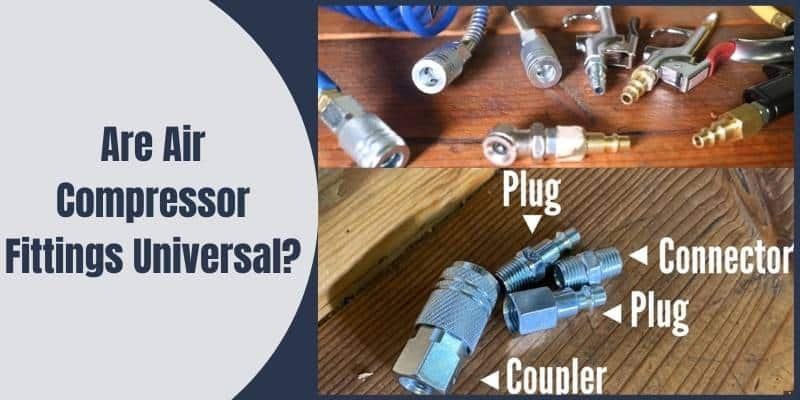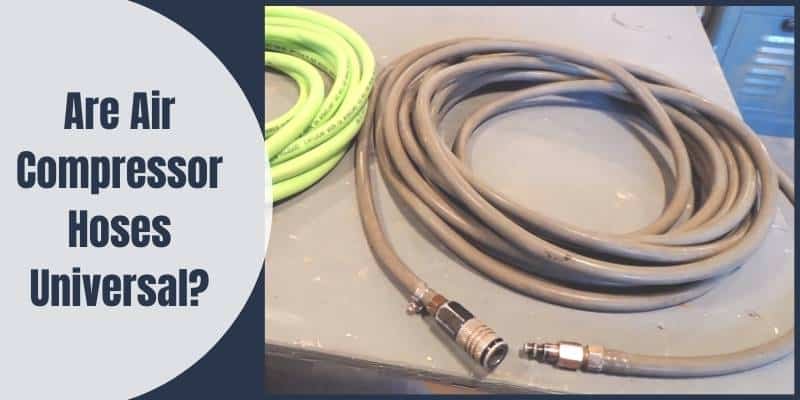Disclosure: This post contains affiliate links and I will be compensated if you make a purchase after clicking through my links. Learn More
Understanding air compressor fittings can be tricky, especially if you have never replaced them or you simply didn’t need to. There are a lot of aspects to the topic, hence a lot of questions come from the new operators that we see on various DIY and contractor’s forums. Among them, one question is very popular: ‘Are air compressor fittings universal?’
Unfortunately, we haven’t found a well-structured article on the web that intends to give a detailed answer to this question. So we decided to take the chance, and here is the result for our readers.
From interchangeability to sizes, identifications to selection, we have compiled all the information (from our experience and thorough research) you may need to learn about air compressor fittings into one place. So, should you wait any longer?

Are Air Compressor Fittings Universal?
If you’re wondering, are air compressor fittings universal? The short answer is no! Air compressor fittings are not universal, meaning they are not compatible with all types of air compressors sold in different parts of the world.
Most air compressor fittings are identified by three main standards: NPT, BSPT, and Metric. NPT (National Pipe Thread) is the American standard air compressor fitting and is compatible with most North American (including Canada) air compressors. BSPT (British Standard Pipe Taper) is the primary standard in the UK and Europe and is also used in Asia, Australia, and Africa. Metric fittings are mostly common in Europe.
None of the NPT, BSPT, or Metric air compressor fittings are interchangeable because they have different representation methods, thread angles, forms, and flow sizes.
NPT and BSPT fittings are represented by the number of threads per inch (TPI), whereas Metric fittings are represented by the pitch. Also, NPT and BSPT fitting threads are isosceles (60° and 55°, respectively), but Metric fitting threads are equilateral (60°). In terms of the flow size, NPT and BSPT fittings are measured in inch (in), while Metric fittings are measured in millimeter (mm).
Are All Air Hose Fittings the Same Size?
No, air hose fittings are not all the same size. There are many different types and sizes of air hose fittings depending on the application.
For example, there are quick-connect air hose fittings, also known as couplers, which come in a variety of (thread) sizes to fit different types of hoses. However, the most common sizes (also known as flow sizes) for air compressor couplers are 1/4″ and 3/8″. These two sizes will fit most average-sized air compressors. If you have a larger air compressor, you may need to look for a 1/2″ coupler. There are also other flow sizes.
Please note that quick connect fittings have a female and a male end that snap together. The measurement of their threads also varies. For male couplers, the outer diameter (O.D.) is usually considered, whereas for females it is the inner diameter (I.D.).
There are also barbed and push-to-connect (PTC) air hose fittings. These fittings are also available in a variety of sizes to fit most popular air hoses.
What Threads Are Air Compressor Fittings?
Most air compressors use American Standard NPT (National Pipe Thread) fittings. The main advantage of using NPT is that it creates a seal as the threads are tightened. This is due to the tapered shape of the threads. There are two types of NPT:
– Tapered: Used for creating a seal between two surfaces. The most common type used with air compressors.
– Parallel: Not commonly used as it does not create a seal, however, can be found on older models or those intended for industrial use where sealing is not required.
How to Identify Air Compressor Fittings?
The biggest challenge to identifying and selecting the proper air fittings is not understanding the vocabulary. So we will begin with some vocabulary related to air compressor fittings.
Here, we will use the word “fitting” as a general term. So, when we are using fittings, we are trying to describe the parts associated with attaching and detaching the hoses and tools to the air compressor.
Fittings that can attach and detach quickly are called quick-connect fittings. They have a quick release valve that allows you to quickly connect and release the air hose from the fitting.
Common air compressor hose fittings include the coupler, the plug, and the connector. The coupler allows the plug to connect with it. They are quick-connect because they allow the operator to quickly connect the plug to it.
The plug inserts are plugged into the coupler. The plug may have different shapes on the end that are set to different standards. The standards for plugs include ARO, Automotive, and Industrial. Individually they are different shapes and will not fit into each other. There is, however, another standard called “Universal” that will fit more than one type of plug.
Another feature to help identify the fitting is the thread at the end of the fitting. Threads have many specifications that stem from standards related to the pipe. Along with the thread specifications themselves, it is also good to know that threads come in male and female versions.
A male thread is inserted and rotated to couple with the female thread. These threads are ¼ NPT which stands for National Pipe Thread. The ‘One-fourth’ relates to Nominal Pipe Size (NPS). This Nominal Pipe Size is the outside diameter (O.D.) of the pipe that these fittings would be connected to. Note that, with smaller size pipes (such as ¼”), there are exceptions where the nominal pipe size may not match the outer diameter.
Another specification related to the thread size is the ‘Thread Per Inch’. For ¼-inch NPT it has 18 threads per inch. Because the threads themselves are made up of multiple angles and shapes, they also have specifications for all the dimensions associated with the actual threads.
Now that we have identified some of the vocabulary associated with fittings, we will go over some suggestions on how to select the fitting for the air hoses and air compressor.
How To Select The Fitting For The Air Compressor?
It’s a good idea to start with an air compressor to see which type of fittings is installed. Two similar sized air compressors can have different fittings. One air compressor has a coupler while the other has a plug. This means that each of these compressors would also accept different fittings.
This is important as it would impact the decision on hoses. A hose should be chosen to match the specifications of the compressor and the intent of use. Once the hose is chosen you will want to match the fittings on the hose to the fittings on the compressor.
Once the compressor, hose and fittings have been considered, the next considerations would be air tools. Some air tools have fittings included in a kit or attached. The air tool fitting should be considered either by taking photos, writing a list, or physically bringing the air tools near the hose and fittings. Once you know the air tool fittings along with the compressor fittings you will then confirm what fittings need to go on the hose.
You would also want to use Teflon tape if the fitting does not already have material to help seal the threads.
In brief, the things to keep in mind are:
– A coupler quickly connects a plug. Most couplers for residential use are Quick Connect and have female thread.
– A plug inserts into a coupler. Most plugs for residential air compressors are shaped to the industrial specification. Plugs can have both male and female threads.
– Most threads standard size for residential air compressors are ¼ -inch NPT. There are many detailed specifications for the thread size but the NPT standards should be enough to match the threads of the fittings. If needed, there are also thread connectors such as a male to male connector.
– If the compressor and the hose has a different thread size for the fitting, it will usually be noted on the box or operator manual for that tool.
Final Words
Hopefully, the article has enriched your understanding of air compressor fittings and helped you find a meaningful answer to your question, “Are air compressor fittings universal?”. If you think the article is useful, feel free to share it with anyone who could also benefit from the information. Have a great day!


